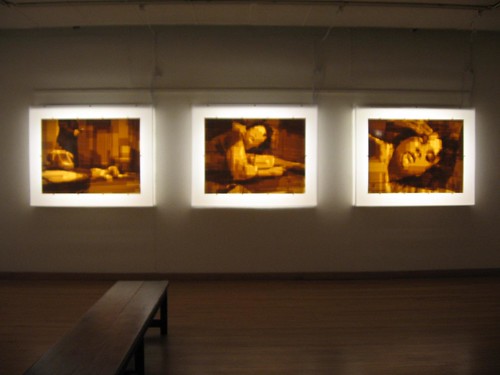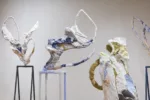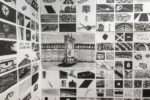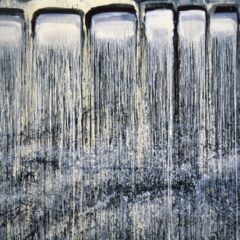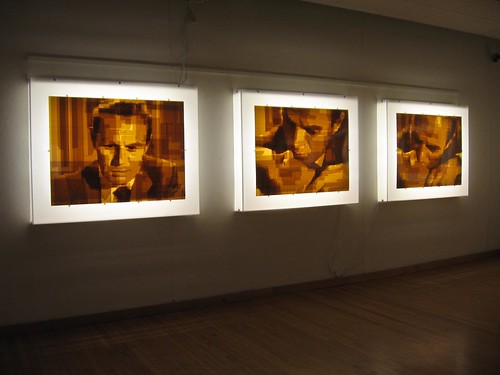
Mark Khaisman’s packing-tape stills on light boxes.
At what point, I say to myself, does an intervention or displacement of some sort become suggestive of something bigger than the mere act of creating a shift. That’s what I came away thinking about at the Wind Challenge Exhibition #2 at the Fleisher Art Memorial, which features work by Mark Khaisman, Kara Crombie and Hope Rovelto.
Khaisman and Crombie are both doing something rather similar in a way–displacing and inserting something outside the normal context.
Khaisman, who is known for his packing tape drawings of noir film stills, is pushing what was in danger of being pure gimmick into something juicier in his exhibit, There’s a Frame Missing.
Riffing on the movie frame, he has created serial drawings of nearly consecutive stills. I was surprised that even though I was looking at more information than a single still gives, the work became even more ambiguous. Oh, the action is clear enough. It is the moral ambiguity that increases as time slows to a halt.
In addition to the packing tape drawings, Khaisman also has included a video installation which plays an edited clip from the source of the stills–Sam Fuller‘s noir film, Pickup on South Street–which involves crime, espionage, and a missing bit of microfilm.
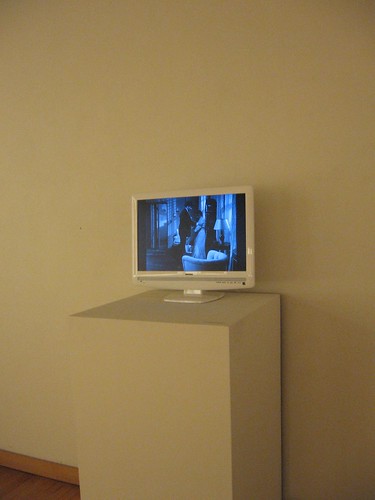
The video clip from Fuller’s noir Pickup on South Street
Into the video clip, Khaisman inserts his packing tape drawings, so suddenly the black and white action pauses and slows for the sepia-tone stills. The sudden dose of layered unreality and the time shift are funny and startling and provocative. Somehow they undermine the suspension of disbelief that sustains a movie. The packing tape pictures, isolated on the wall in their lightbox frame, seem believable and realistic. Once they are inserted in that alien film environment, they become most strange and wonderful, raising issues about what is real, what is realistic, and what is believable.
With the insertion into the video, there’s a sense of loss–lost time and lost narrative tension. I wondered if Khaisman is also playing with his own lost past as a Russian native, exploring Cold War politics expressed by this 1953 film, in which good guys and bad guys are not all that easy to tell apart. But putting the images into sepia, is he saying it’s the past, or is he saying it’s just another viewpoint?
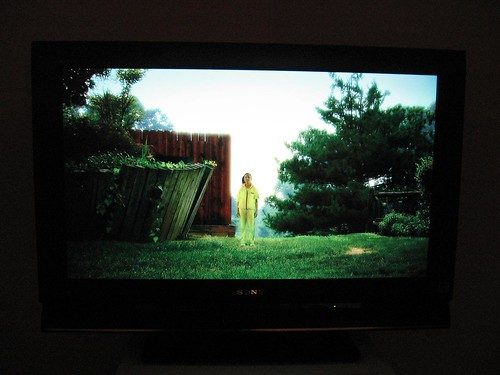
Kara Crombie jettisons narrative in her video installation Portraits 1. She has taken “moving portraits”–videos of people standing or sitting and fidgeting (I’m thinking Andy Warhol thoughts here) and placed them in digitally created faux landscapes and interiors, that she compares to paintings. The landscapes are beautiful, and the interiors have the quotidian ordinariness of young people’s apartments and real lives. The hyped up color of the landscapes remind me of old Technicolor movies, but the people look real enough–almost.
Some clips from Crombie’s video installation
The portraits are on three different screens, so if you don’t like one, you can turn around and look at another.
Crombie relies wholly on the disjunction between the person (reality) and the setting (manufactured) to shake things up. I found myself engrossed in some portraits, bored during others. The one that worked best for me was of Crombie’s fellow Vox Popper Andrew Suggs (I think it was Andrew), sitting in a “kitchen,” looking rather antsy. His antsiness was enough to create a compelling narrative for me.
In the case of CGI in movies, the disjuncture might as well not be there because it is overtaken by the narrative. The disjuncture between reality and unreality, to work as art, needs to be evident enough yet ambiguous enough and wide-ranging enough to create a narrative in the viewer’s head. Crombie sometimes gets so realistic technically, that she loses the ambiguity in those videos– a cost of technical success.
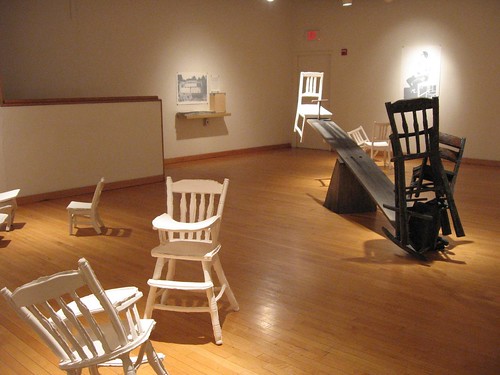
Hope Rovelto, installation shot at Fleisher
Rovelto casts ghostly white chairs out of porcelain. Some of them are broken down and bent, others in whole condition. They are symbols of people, a traditional metaphor, and also of people missing–another traditional, metaphorical use of chairs. And they are memories, an idea emphasized by the scratched-into-looking silkscreens of blurry snapshots on the wall. It is the memory part of this installation that works the best.
I was interested to read in the gallery notes that Rovelto mass produces these chairs. That seems interesting–and surprising. The idea of mass production seems like fertile ground worth exploring further.


